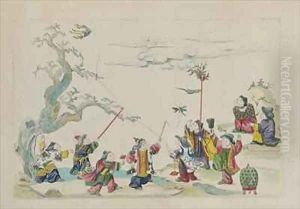Jean Antoine Fraisse Paintings
Jean Antoine Fraisse was a French artist born in 1813, whose work primarily spanned the 19th century, a period that witnessed significant transitions in the art world. Not much is widely known about his personal life, and he remains a somewhat obscure figure in the broad panorama of art history. However, his contributions, primarily through painting and drawing, reflect the artistic movements and styles that were prevalent in France during his lifetime.
During the 19th century, France was at the heart of many revolutionary artistic movements, including Romanticism, Realism, and Impressionism. While it is not explicitly documented which movement Fraisse aligned with, his era was ripe with innovation and change, suggesting that his works might have been influenced by or reflected the characteristics of these movements. Artists of this period were deeply involved in exploring new techniques, experimenting with light, and expressing emotional depth and social realities through their art.
Fraisse, like many artists of his time, would have been trained in the traditional academic style, which emphasized classical forms and subjects. However, the evolving artistic landscape of France provided a fertile ground for experimentation. Unfortunately, without specific examples of his works readily available for analysis, it is challenging to categorize his style precisely.
Jean Antoine Fraisse's death in 1883 marked the end of a career that spanned a fascinating period in art history. Though he may not be as celebrated as some of his contemporaries, understanding artists like Fraisse is crucial for a comprehensive understanding of the era's artistic achievements. His life and work serve as a testament to the rich, albeit often overlooked, tapestry of 19th-century French art. Researchers and art historians continue to uncover and reassess the contributions of artists like Fraisse, ensuring their rightful place in the annals of art history.
